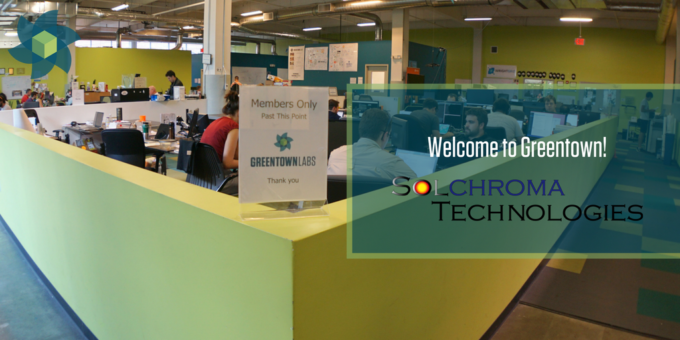Have you ever been traveling through a place like Times Square and felt blinded by all the flashing billboards? Are you glad that you don’t live with a window facing a giant LED sign 24/7? One of the newest member companies at Greentown Labs is tackling that problem by using new technologies drawn from unusual inspirations. You might be thinking, what could cuttlefish and a billboard possibly have in common? Solchroma’s story is one of developing much needed innovations through creativity and research.
Solchroma Technologies is creating a new form of digital signage that has origins in the amazing camouflage of cuttlefish. A few years ago, Solchroma CEO Roger Diebold and CTO Sam Shian became involved in a DARPA project with the goal of imitating cuttlefish skin, a species Roger calls “chameleons on steroids.” Roger and Sam became fascinated by the colored “chromatophore” cells throughout cuttlefish skin which expand and contract more than 10x in area to dramatic effect, mimicking their surroundings. Cuttlefish use several layers of chromatophores as a primary way to create camouflage patterns that are nearly unlimited.
Roger and Sam had been researching rubbery electro-active polymers for several years, and applied their knowledge to imitating the visual action of chromatophores. The Solchroma team used their electro-active polymers to pump ink—just like inkjet printer ink—onto a surface to display a particular color, or below that surface to hide the color. With electronic control, layering cyan, magenta, and yellow inks allowed creation of a full color pixel, and arranging pixels into an array enabled images that could come from any digital source. The way the pixels were designed gave brilliant and bright colors without generating light, contributing to a “painted” look that looked best under bright lights.
Today, Solchroma has developed a model that is shaking up the billboard industry. After speaking with display experts and attending numerous trade shows, Roger and Sam realized that their color-changing concept could be used in large-area digital signage, where generating high color quality outdoors is essential—Solchroma was destined to generate vivid, reflective colors from the get-go. Previous attempts at creating full color reflective signs have flopped because the colors were too dim or washed-out. In advertising, color is king, and Coca-Cola pink will not suffice.
The prototypes Solchroma is creating could be truly disruptive to the digital signage industry. Currently, LED screens are the norm having no serious competitors. However, LED technology is bogged down by numerous cost and regulatory issues that are dramatically reduced with Solchroma’s sign hardware.
In addition to price points greater than four years of private college tuition, digital billboards require massive amounts of LEDs operating in close proximity to each other. Using multiple LEDs in confined spaces can cause heat buildup and drain the efficiency they are often known for, driving electricity costs through the roof and contributing to environmental pollution. In fact, some digital billboards can use up to 30 times the energy of an average U.S. home! Because Solchroma’s signs do not generate light and consume far less energy than LED solutions, they are vastly greener and could save customers thousands of dollars per year.
The second issue with LED screens is light pollution. As Roger puts it, “not everyone wants to feel like they are walking through Las Vegas.” Solchroma’s prototypes are much less gaudy while still packing all the vibrant punch of a full-color display. Additionally, the billboard prototypes could be used in places where zoning code regulations have been established restricting LEDs.
Despite historical challenges in the display industry to generate returns for investors, Solchroma positions itself as a sign company unencumbered by many of the bottlenecks traditional display startups face, such as supply chain limits, materials selection and processing methods, brightness challenges, and regulatory restrictions. It seems the market has been looking for reflective, full-color for some time, and Solchroma thinks it has the right tech to succeed.
So far, the Solchroma team has been enjoying numerous aspects of the Greentown Labs community, such as the machine shop’s prototyping capabilities. They have been especially impressed by the entrepreneurial spirit at Greentown Labs and Roger says the dedication and passion of the startups in our community make him believe that Greentown Labs is a place where Solchroma can thrive and grow.
We think so, too! We’re super excited to have Solchroma join our community and can’t wait to see Solchroma signs popping up everywhere. Stay tuned for updates from the Solchroma team!


